by Tom Gaylord
Writing as B.B. Pelletier
Part 1 Reloading .22 rimfire cartridges
Part 2 Reloading .22 rimfire cartridges
This report covers:
- All started here
- Bitten!
- Problem
- Solution
- Bottom line
- Airguns?
- By the way
- Summary
If you are a regular reader of this blog you know that I am exploring the reloading of .22 rimfire cartridges. Researching that endeavor has opened my eyes to a world of reloading that I didn’t know existed. Not only are people reloading .22 rimfire cartridges, they are doing it for most other rimfire calibers. Today will be an airgun-related discussion about bore size that started as research for reloading the .41 rimfire short case.
All started here
It all began when I posted the photo of the Remington double derringer in Part 1 of the reloading series. That image caught my attention and started me on a journey to see where this goes.
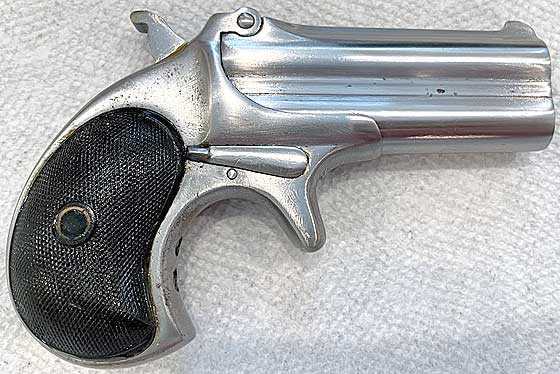
When I first posted this picture I said your grandfather’s .41-rimfire derringer is a good reason to reload rimfire.
As I did my research I discovered two new books that seemed to offer a lot of valuable information. The first is titled The 41 Short Rim-Fire and subtitled Deadliest Round in the West. It’s by Brendan Michael Murphy and was self-published in 2017. My topic today came from this book.
After ordering that book I realized that people were not just reloading .41 rimfire shorts, they had to be shooting them! And, of all the guns that shoot them, none is more universally recognized than the Remington double derringer! Was there a book about that gun, I wondered? Yes, there was. In 2008 Graphic Publishers put out Dr. William H. Elliot’s Remington Double Deringer. This book has four authors — Douglas S. Drummond, Rudolph H. Johnson, MD, Elias J. Williams, Jr. and James W. Barnard. I ordered that one, too.
Incidentally, the spelling of Deringer is correct for the man, Henry Deringer, as well as for the guns he created. The spelling derringer is the colloquial term that has entered the English language for a short pistol. Either spelling is correct.
Bitten!
I was bitten! Not only did I want to know what it was like to shoot a .41 rimfire short — I wanted to know what it was like to shoot one in a Remington double derringer! But before I took the plunge, I read both books and gained a lot of knowledge about the firearm and about the cartridge. Therein lies my introduction to today’s report.
The first book was written by an author who just wanted to set the record straight. I can identify with that. For years writers have written that the .41 rimfire short is a weak and inaccurate round. It propels a 135-grain lead bullet out the spout at 375 to 450 f.p.s. — hardly a good defense weapon. Or so the writers said. But author Murphy wanted to know more. He wanted to know why the round was so weak, when his research told him it should have been far more powerful.
In his collection of Remington derringers Murphy discovered that the earliest ones (their entire production was from about 1867-1935 and the early ones were made 1868-1888) were obviously made for black powder because that was all that was around. Remington continued making the gun more or less in the same way for those black powder cartridges, right up to the end of the 19th century (1898, or so). By that time semi-smokeless gunpowder had been invented and by the start of the 20th century smokeless powder was on the market. Black powder cartridges were still on the market and would be for several more decades but smokeless powder was the wave of the future.
Problem
That caused a problem for Remington. Smokeless powder creates more pressure than black powder when both are loaded correctly. Yes, black powder can blow up a gun, but that’s when it is not loaded properly. Remington wanted to continue making their double derringer, but they knew that cartridge makers would soon be loading them with smokeless powder. How do you keep from blowing up the older guns that have been around for almost 40 years when smokeless cartridges are used?
Solution
Brendan Murphy discovered that Remington did it by making the bore of the newer derringers smaller — 0.399-inches as compared to 0.405 to 0.407-inches for the older pistols. He slugged the bores of examples of Remington double derringers in his own collection to prove that. He also measured the bullets in both old black powder cartridges and in newer smokeless rounds. Sure enough, they followed suit. Shoot a smokeless round in an older derringer and there is so much space around the smaller bullet that the pressure never builds. Shoot a black powder round in a newer derringer and — well, the pure lead bullet gets mangled on the sides but the pressure doesn’t rise above where it normally should. Either way the shooter is protected.
And that is why writers have said all that they did about this old cartridge. So Brendan started experimenting. He pulled a bullet from a recent rimfire cartridge and it measured 0.401-inches in diameter. That will hardly work in a bore of 0.405 to 0.407-inches! But it’s perfect for a more modern 0.399-inch bore.
Bottom line
I’ll cut to the chase to get us to where we need to be. Using the more modern undersized bullets in an older (circa 1868 to 1888) derringer, Murphy got velocities of 365 to 453 f.p.s. — about what the gun writers have claimed. At an average velocity of 421 f.p.s. the 130-grain bullet produces 51.18 foot-pounds of energy (less weight for the bullet comes from the smaller diameter). That’s less energy than a .22 short!
However, when he reloaded a couple cases with a modern compressed load of 13 grains of a mixture of FFFG and FFFFG black powder and a bullet that measured 0.406-inches in diameter, the velocity was 586 to 611 f.p.s — for the same cartridge in the same pistol! At an average 601 f.p.s. for the 135-grain bullet (heavier because of a larger diameter) 108 foot-pounds were produced. That’s about equivalent to a standard speed .22 long rifle cartridge.
Airguns?
What has any of this to do with airguns? A couple things, actually, and you need to know your airguns to understand. First of all — airguns are still shooting black powder. What I mean by that is airguns still use air. We breathe the same air that Jesus, Charlemagne and Abraham Lincoln breathed. And, since our guns run on that air, nothing has changed in the power department. More air means more velocity for a given projectile — just as it does for black powder. A longer barrel means more velocity for pneumatic airguns (multi-pump and precharged) just as it does for black powder firearms.
And bullet size matters. Only we don’t shoot bullets, except for big bores and those smallbore guns that shoot solid slugs. We shoot diabolo pellets. What’s different about them is their flared skirt that conforms to the bore of an airgun when the shot is fired. It does so at pressures that are far below those of black powder cartridges — even little ones like the .41-caliber short. A precharged pneumatic might present air pressure of just 800-1,000 psi to the base of a pellet, while a .41 rimfire short might present 8,000-10,000 psi to the base of its bullet. I know I’m just guessing at those black powder numbers, but I do know that black powder pressure peaks around 12,000 and 15,000 psi in rifles with very long barrels. At that pressure level it would really be stated as copper units of pressure or CUP, due to the test device used to obtain them.
The point is, the base of a pellet has to flare easily, where the base of a lead bullet has more pressure to squash it out to fill the bore. And this is why, as black powder shooters, we know the importance of softer lead bullets. But I digress.
As airgunners, we understand the importance of pellet skirts, but what about pellet heads? Remember those gun writers who said the .41 rimfire short was underpowered? They also said it was inaccurate — for the same reason — because the bullet didn’t fit the bore. Not that any of them bothered to check — or even to understand!
But the readers of this blog do understand and they understand quite well. We even have a reader, Jerry Cupples, who makes the PelletGage that allows us to accurately measure the size of our pellet heads. And I have a very special PelletGage that Jerry once made. It goes to the thousandth of a millimeter instead of the hundredth. I don’t care whether the holes are exactly the sizes that are marked. All I want is pellets with heads of a certain diameter that I can relate to a general size range like, “Larger than 4.51 mm.”
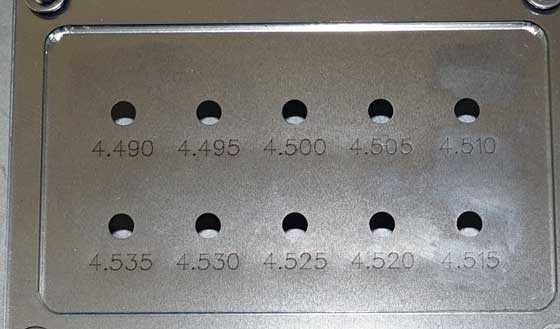
This is the PelletGage I used.
I sorted .177-caliber JSB Exact Heavy pellets for a test in Cloud9’s new RAW field target rifle. I wanted them all to be the same size and according to the PelletGage they have heads larger than 4.510 mm and smaller than 4.515 mm.
Out of 36 pellets gaged, 20 were of a uniform size of 4.515mm and 16 had heads of a different size. Of those 16, 14 were smaller than the 20 I accepted and 2 were larger. This tells us that JSB pellets are very uniform in size and after we shoot them we will know how they relate to the RAW rifle, in the accuracy department.
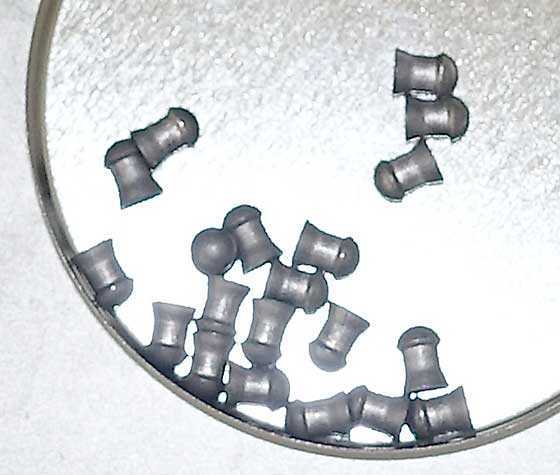
Twenty of 36 JSB pellets were uniformly the same size.
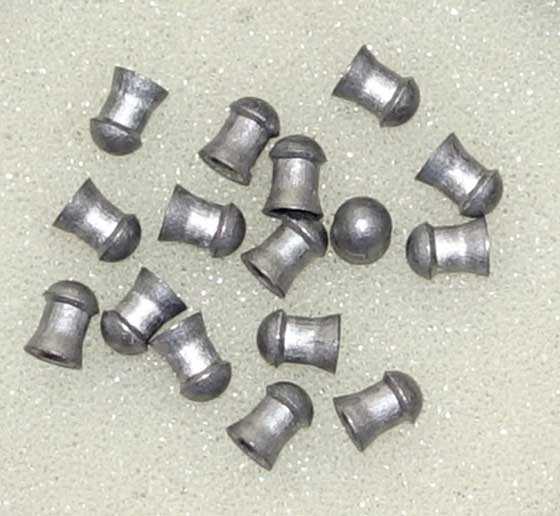
Sixteen of the 36 pellets gaged were a different size. Fourteen were smaller and two were larger.
By the way
Oh, and by the way, I did get a Remington double derringer to use in the fuiture of the rimfire reloading report. It was originally shipped from Remington in November of 1923, so it had to have been made earlier than that — but not much. From the two books I mentioned earlier I know it has a 0.399- to 0.401-inch bore, and I can concentrate on getting a mold for a bullet that size, once I slug the barrels to confirm it.
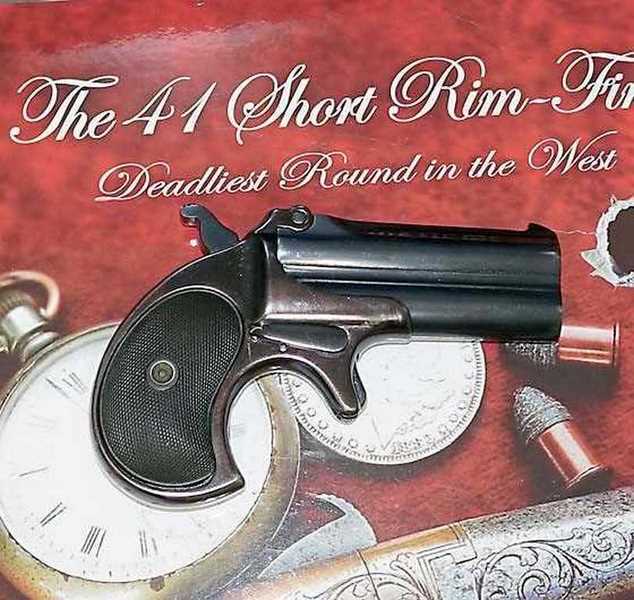
My new/old Remington double derringer.
My new/old Remington derringer was re-blued at some point, so a lot of collector value was taken away. But it’s solid, it locks up well and it hasn’t got any of the fatal flaws of this firearm, such as cracked barrel hinges.
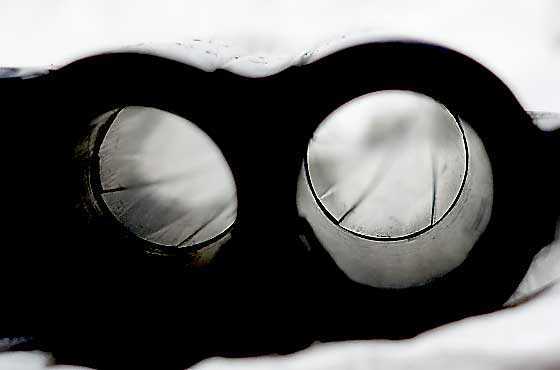
This pistol was either not shot very much or it was well taken care of. Finding crisp bores like this is not common.
Summary
Some people pay no attention to what’s going on. That’s why Remington had to downsize the bores on their derringers — to keep people safe when the ammunition changed. With the information gathered in the two books mentioned above I’m going to leapfrog ahead of the pack in my quest to reload for the .41 rimfire cartridge.

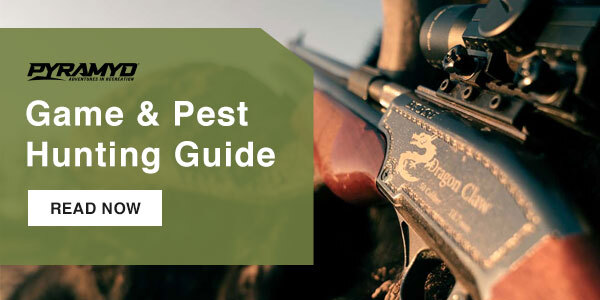
B.B.,
My goodness you’re on your game. As I read through the blog about a .41 caliber Remington double derringer my first thought was to warn about cracked barrel hinges and shot out barrels since these are common flaws in most surviving specimens.
I’m impressed by your find since it’s rare.
Kevin,
I look at Guns International now.
BB
B.B.,
What a difference that 0.005″ makes! Is there a shortcut in finding the right pellet size for airguns? Can we push a pellet down the bore then measure it and use that as a starting point?
Siraniko
PS Section Bottom line 1st paragraph 3rd sentence: “At an average velocity of 421 f,.p.s. the 130-grain bullet produces 51.18 foot-pounds of energy (less weight for the bulklet (bullet) comes from the smaller diameter).”
Siraniko,
In “By The Way” B.B. says, “From the two books I mentioned earlier I know it has a 0.399- to 0.401-inch bore, and I can concentrate on getting a mold for a bullet that size, once I slug the barrels to confirm it.”
So you can slug an airgun barrel and get the actual bore size. It then all depends on the type of rifling (or none) that determines what head size you start your search at.
For pellets in low powered airguns I want the head to ride the Lands and not engrave all too much. If it is a PCP with some “kick” shooting bullets i go with what B.B. always recommends as a starting oversize and that is +0.001 for .50caliber and below. For larger I may take it to +0.0015 to start the search.
For my .58 DAQ Shortrifle and Pistol slugged at .575 for lead ball i get actual 0.580 dead soft ball. For bullets it seems .577 works best.
shootski
Shootski,
Thanks for explaining where to start. Coupling slugging the bore with a PelletGage to measure accurately can probably help narrow the field in looking for an accurate pellet.
Siraniko
Siraniko,
Fixed them. Thanks,
BB
B.B.,
Really a great blog topic both for the Deringer and the Bore size knowledge for airgunners and the “new to airguns” readership.
I dug up this information that may be of interest about the evolution of propellants: https://futureforce.navylive.dodlive.mil/2016/11/powder-and-propellants-for-the-navy-a-history-of-an-energetics-leader/
I get to travel in my Sea Kayak to/from this place from time to time.
shootski
Shootski,
And maybe now they are researching electromagnetic propulsion otherwise known as rail guns?
Siraniko
Siraniko,
Rail Guns are energetic! Lol!
But there are other surprisingly energetic things out there….
shootski
Thank you shootski for that link. Very interesting read. I worked for IBM in Norfolk in the 60’s and spent many hours at OPCON and FICLANT but never heard of Indian Head.
B.B.
I love the way your mind works!
Sorry I have a whole bunch of stupid questions:
-Who was Dr. William H. Elliot’s , and why was it his Derringer?
-When I got my first Chemistry set I made”gunpowder”, Saltpeter, Sulfur, and Carbon(charcoal). Is this what you
call blackpowder?
-What is the chemical composition of both Black Powder and Smokeless Powder? Science rules…..
-Y
Yogi,
Elliot invented this derringer. Remington then bought it from him.
Yes, you have given the contents of black powder.
For the last question I would need a whole bookshelf. Smokeless powder is a hige subject, but a lot of it is nitroglycern is an inert filler. But its way more complicated than that.
BB
BB,
Who cares about collector value? It is shootable and it was likely cheaper. These are awesome little cartridges and their big brothers are even more awesome.
BB
Abe Lincoln is smiling again. BB, you hit a home run with this report. First time I have heard why the old .41 rimfire was so weak. Now we know it ain’t so.
Deck
Abe is dead because of a Derringer. Why the happy face?
R
R
Presidents Lincoln and Jefferson are our two greatest presidents in my view. So why the happy smile? He was unusually curious about how things worked. He would take clocks, guns, anything mechanical apart to fix them and understand how they worked. Our mentor on this blog shares that trait I think.
Stay safe!
Deck
Abe Lincoln is not famous because of his curiousity for mechanical things or his tinkering skills.
Thomas Jefferson was a slave owner who cheated on his wife. If he’s happy about anything, it’s
the fact that that the recent Coup had no military support, IMHO. Less so that you can load nitro based powders in an antique if you get the projectile dia. right. I’d have to give the ‘greatest’ tltle to Mr. Lincoln.
He was far ahead of his time, considering the context of the day. I would have hung the rebel leaders, taken their land and given it to Black Americans, luckily I wasn’t in charge. I did find two unopened tins of A.A. .177 heavys in the back of the drawer last night. Keep on shooting!
R
R
Oh my goodness.
Off-topic, sorta, but here is another semi-miniature fun shooter, though not as inexpensive as the toothpick crossbow.
https://tippmannarmory.com/gatling-gun/
Fawlty
Pretty cool but did you see the price. At least they made it to shoot a popular round.
Potassium nitrate, not ammonium nitrate goes into making black powder. Making BP is a skill ALL folks should have. I have shot hundreds of BP .22 rimfire shells from my granddad’s Winchester model 61A and BP shotshells from his Davenport single shot 12 ga (shown) If anyone does this, thoroughly clean the barrel immediately after shooting. The 61 lends itself well to this since the bolt is easily removed, as is the stock, so the barrel can be properly cleaned.
Cobalt327,
Yes, potassium nitrate! I used to know that. 😉
BB
Cobalt
You load the .22 rimfire yourself? Have you you used other powder besides black powder?
I’m going to get one of them reloading kits BB has been reporting on. I got a bunch of .22 rimfire cases and lead saved up.
Yes, I loaded them myself. I used a Lyman 22 mold, it was made to be used with a gas check but by leaving it off, the tail could be fashioned into a sort of heel. Lots of work, it was more just to see if I could do it, but it’s really not practical. I made Armstrongs to use for primer, but I would not suggest anyone else do it. I’d try NAA .22 slugs if I were going to do it again.
I can’t personally recommend using smokeless. The few times I tried it, I used Bullseye because it was on hand and when they lit off, the results were very erratic. Had a few cases rupture, too, but more times than not, they didn’t ignite, just the primer would go off and either lodge the bullet in the barrel, or it would only go a few yards. That said, I’m sure there are better powders than high nitro content Bullseye!
With my homegrown BP, I simply filled the cases to the brim, seated the bullet, and shot. The downside was all the cleaning afterward.
Cobalt
When you loaded the black powder to the brim and compressed. What grain bullet did you use and was it a long rifle case and what velocity did you get?
I want to make 700 and 900 fps rounds with a 40 grain bullet. If I use black powder I’m sure there will be air space between the bullet and powder. Have you done that before? And did you use a filler for the air space?
The bullets were around 50gr. I used only LR cases, and no idea of the MV, but nowhere near the speed of sound. I’d guess 500-ish, but I was w/o a chronograph back then so this is a guess.
I have no experience using BP with an air space- I was taught to never do that. The BP was compacted when the bullet was seated. I rigged a tubing cutter to crimp with but there are tools for that now, or so I’ve heard. “My” ideas were largely gleaned from various online sources so the info is still out there, and by now, I’d imagine it has been greatly expanded upon, so researching it will likely net you good results with current part numbers, etc.
When making BP, the charcoal is uber important! Look for air float willow. I never used charcoal brickettes or chemicals from the garden center, etc. I bought from places that cater to fireworks makers, which I was also doing at the time. Adding a small percentage of red gum will really wake up BP, too, but it’s probably best to start out with the basic recipe and venture further once you have that down pat. A ball mill really helps, but not absolutely necessary. A rock tumbler will suffice for small batches.
Good luck!
Mark
Cobalt
One thing I see is I need to do alot more research.
BB
What I’m wondering is how loud the derringer is when it shoots at that low velocity. I bet the charge is fairly loud when it shoots. That’s a pretty big chunk of lead to get moving at even those low velocities. I bet it’s got a little bit of a kick to it too.
Next question is how accurate were they with that short barrel and at what distance. They were usually used at I guess you could say point blank distance. Or am I wrong.
Gf1,
I bet it kicks, too!
They could supposedly hit a person at 10 yards, but I think 20 feet was a more realistic distance.
BB
BB
You are going test when you do some loads aren’t you?
And maybe I watched to many westerns when I was a kid. But didn’t they have a wrist holster and they would hide them under their long sleeve shirt.
GF1,
Of course I’m going to test the loads I make.
And yes, you probably did watch too many westerns.
BB
BB
I think your wrong.
I got this from this link.
https://truewestmagazine.com/hideout-hijinks/
“Some professional gamblers were known to have rigged special devices that allowed them to wear a derringer up their coat sleeve, inside of a hat or in a small holster attached to their galluses. The gun did sometimes get entangled in clothing, however, when the gambler withdrew it from a coat or trouser pocket.”
There was more things I could of posted. They did alot of things back then I bet hasn’t been past on in time.
BB,
I have a Diana 23 and 25 , both with direct sears. My neighbor has a BSA Cadet Major in OK condition. Seems to shoot with plenty of power( like the Diana 23 —- in the mids 400s). The stock has scratches and dents but no cracks. Needs to be refinished. The bluing is almost gone, has rust patina all over but no pits. Needs a new rear sight. I work long hours and haven’t had a chance to shoot it (Plus, he doesn’t want any contact with anyone right now ). Looks like a mini BSA Airsporter. Love it ( I own a Mk I). He wants $125.00 . The 13th edition of the Blue Book says it is only worth $40.00 in 20% condition. Would like something different besides the German offerings on this size scale. Do not care to make it a bright penny, just as long as it shoots smooth and straight. I know I will have a hard time finding a rear sight.
My question is, besides the amount of $125.00 being asked, how does the Cadet Major compare to a Diana 23 or 25 with direct sear triggers? Would I miss anything in this British offering compared to the Germans’.
Alex2no,
I don’t have a lot of experience with older BSAs, but from what I have seen they are made in odd ways. Depending on when the rifle was made it may have missed the severe UK cost-cutting that made for quirky construction. I bet reader Iian could shed more light on it.
/blog/2017/06/bsa-meteormark-i-part-8/
/blog/2014/08/bsa-meteor-part-9/
For my money the Dianas are the better way to go. And I also think $125 is way too high for what you described. It sounds like an emotional attachment.
BB
B.B. and Readership,
I had an exchange with reader AlanMcD about water output from compressors entering the pressure vessels we airgunners use the other day. I will post this breaking information on Chloride and corrosion to that exchange but thought i would share on the current page for maximum coverage for the Readership:
https://phys.org/news/2021-01-supercomputer-chloride-role-corrosion.html
Some of you are like, SO WHAT! But the point is how little we actually know about METAL corrosion beyond what has been observed and reported on…we all know the problems with ALL reporting sources and the coverage of (AS BEST we know it) TRUTH!
Digression: With ALL types of media, from books to The Internet my comment to folks who believe it all is TRUE and ACCURATE I ask these simple questions: About things that you have First Hand Knowledge how often are reports about that topic 100% correct; 1:10? Do you think other folks, who have First Hand Knowledge about other things you don’t have Direct Knowledge about, experience the same miserable 1:10 100% accuracy rate? Knowing your sources of information is the first step to wisdom. Using multiple sources is Devine. END OF RANT!
Lest you think this is about current events be assured that is not the case in this RANT of mine! It is aimed at the disinformation out there about CORROSIVES. Any other applications of this KNOWLEDGE is at your own risk.
shootski
B.B.,
So my Search Bot is now getting smarter and results on corrosion have started to cascade:
https://phys.org/news/2018-10-unmasking-corrosion-thin-metals.html
I’m certain more will pop up in the next few hours/days.
Just like in airguns we are all on the EDGE of a Watershed Era…that watershed points are knife edges and are dangerous points in history are a well known fact! Will we get to the other side of the blade?
I pray we do!
shootski
Shootski,
Yes,.. I can see where the slow corrosion (while maybe unseen),.. can lead to a severe corrosion of integrity. Metal speaking,.. of course.
Chris
Chris USA,
I have been a student of all forms and types of METAL for most all of my life!
https://www.metalsupermarkets.com/metals/
shootski
What I got from the article
According to scientists, if I rub the rusted and corroded metal parts of my old air rifle with a nickel ( five cent coin), the rusted old rifle will be worth $ one trillion dollars in the not too distant future.
Twitting the good news to the rest of the world.
Will be investing in nickels futures. Do not need no stickin scientific report telling me there will be a shortage of nickels.
B.B.,
What an awesome report today! My Dad and I used to watch old Westerns on Saturdays, and the Remington derringer was often seen; I thought they were just so cool. Hence, I was devastated to read reports of velocities under 400 fps. THANK YOU for setting the record straight! And as for your new-to-you Remington, who cares about the collector value? That thing is awesome! Once you get the bullet molds, I would love to see a set of reports on that gun alone. The bores look great, and the coolness factor of that pistol is off the charts!
I am happy for you! =>
Take care & God bless,
dave
Just say’n. If this derringer rimfire round didn’t kill ya I bet it was breaking ribs and knocking you on your butt.
Bet its got a heck of a lot of knock down power.
I hope BB does some knock down tests with his derringer after he gets some cases reloaded.
GF1,
I do not imagine that getting a hole put in you,.. from anything,… at any fps,… is a good thing. My impression of them is that you get a quick, close shot off and that gives you a chance to scramble before things get real serious. No fun anyway you stack it.
Chris
Chris
Yep.
Love History,
October 13, 1795
Napoleon defending the National Convention. Sweeping the streets of Paris with cannon fire.
Eyewitness reports state Napoleon yelling “Feu —- let them eat lead.”
RR
Did you get to shoot your Maximus yet?
To whom it may concern,
If they try, TCFNAC can build a PCP that does not leak. My Maximus came with air in it. I filled it to 2000 PSI and it is holding just fine.
GF1,
I have not shot it yet.
RR
My Crosman/Benjamin pcp’s have held air. Something I usually dont think about with them.
GF1,
You are fortunate. I have read many reviews where folks are sending their Fortitude or Maximus back because it will not hold air. This is pure speculation on my part, with a touch of personal experience, Crosman has been bought out by Velocity Outdoors.
VO would like a return on their capital investment. One way is to ramp up production of the hot sellers. Also you discontinue the slow go. The Discovery sales were slow, the profit margin was low and they are a parts drain on the hot selling Maximus and Fortitude.
They have back orders on the Fortitude and Maximus. The Fortitude has a larger profit margin. Who gets the parts? This is why unless you find old stock, 🙂 it can be difficult to get your hands on a Maximus right now. I can even see the Maximus going the way of the Discovery.
What is another way to increase profit margin? Reduce production cost. Time is money. Maybe you push the assemblers to increase production numbers. Maybe you delete a step or two in quality control. Get the back orders of the Fortitude out the door. Oops, some of them are leaking. Enough of them are leaking that the word gets around that it is a crap shoot to find one that does not. After a bit of this, sales will fall off drastically.
This is a disease that if it is not dealt with properly will spread to other production lines, such as the Marauder and SAM.
Like I said, this is pure speculation on my part, but I have seen similar before.
As an aside, my Maximus came with some air in it. I have filled it to 2000 PSI. It is holding it quite well.
RR
As you know I have had several Benjamin and Crosman pcp’s and have had good luck with them.
I did have one gen1 Marauder that had a slow leak but the other gen1 was fine.
They went to a black sealer on the threads on (all) of the Benjamin PCP’s after the gen2 Marauders came out. Pretty much after that you stopped hearing about leaks. And the WildFire doesn’t count. They needed to do a few things and it would of been leak free too.
Anyway just going from experience with probably at least 10 or more Benjamin and Crosman pcp’s I have had.
B.B. and Readership,
I was re-reading my above post about Bore Clearance and realize a serious omission! When we talk (write) about pellets we switch back and forth from caliber to millimeters for head and skirt size giving it next to no thought with no issues. But I noticed in my post about oversize choices I make I mostly left them unit-of-measureless. That is BAD!
When I thought about how much different the thousandths dimension becomes with the easy switch from ” (inch) to mm!
0.001 millimeters to 0.00004 inches is no small matter to overlook.
And, going the other way just doesn’t look that impressive
0.001 inch to the millimeter’s 0.0245; but it is exactly the same gap between projectile and Bore! Just doesn’t jump out at you as much until you realize that you switched from English to Metric and the pellet head size you bought is rattling down the Bore or just won’t enter the breech/barrel without a solid wack from a ball-peen hammer.
shootski
Shootski,
Yeah when the readership on the blog starts throwing measurements at 0.001 inch initially I was skeptical of that measurement until I converted it to metric terms. This kind of measurement mix up also caused the Mars Climate Orbiter to fail to achieve its goal.
Siraniko
Siraniko,
So,… it all comes down to .0001 of a millimeter is better/more precise than .0001 of an inch because the [base] unit (mm) is much smaller than (inch). Got it. Where do we draw the line as shooters?
I did not know that about the Mars Climate Orbiter.
Chris
Chris,
Caliber is a term for inch measurement. .50 caliber is one half an inch.
Siraniko and others living around the world think in millimeters. This old brain of mine thinks in inches. I can pull out the formulas and such and convert back and forth, but to me it will always be inches. Period.
I do not have a target range at 10 meters. I have one at 10 yards. As I set up my range, I will have targets at 10, 25, 50 75 and 100 yards.
RR
Right I don’t think some people realise that.
Like .35 caliber is basically 350″.
A .357 caliber is .357″.
And of course bore size and bullet and pellet size differs some from the caliber to inch measurements.
Chris USA,
Do you remember the Myopic Hubble Space Telescope? There are unfortunately many conversion error induced failures everywhere and they cost us Billions.
shootski
Shootski,
I do. I have always been interested, but in a casual way. Some of the images we are getting from deep space are just simply amazing.
Chris
Chris USA,
Gunfun1 you need to read the link! It has an answer to a question you have asked a number of times without getting an answer; especially with your fast shooting SAM! BELIEVE IT OR NOT!
“Where do we draw the line as shooters?”
For starters we make certain we keep our units straight! But if your question is the more fundamental one about pellet head (Bullet/slug diameter) size choice based on Bore size there are a number of schools of thought; choose one since it is just a starting point instead of just buying different diameter sized projectiles. Here is the religion (school of thought) I adhere to! OBI WAN would be proud of me!
https://interestingengineering.com/what-is-the-difference-between-bullet-sizes
Also check out B.E. Spencer! He is Black Powder ML mostly but a REAL shooter nevertheless!
http://home.insightbb.com/~bspen/index.html
shootski
Shootski
I work with converting metric to inches every day at work.
There is a big difference.
Gunfun1,
Yup! ;^)
Bet you have seen some real SNAFU!
shootski
Shootski
Yep. Heck we got kids coming on that don’t know how to read a regular mic let alone do conversions.
They want monkeys now days not machinist. Button pushers is what we call them.
Mounted one of these on top of my Maximus this evening. It is sitting too high for my liking, but will do until I can get the mounts I want.
/product/utg-3-12×32-ao-bug-buster-rifle-scope-mil-dot-reticle-1-3-moa-1-tube?a=7972
I think this will be a good one for the Maximus.
RR
Yep good choice. Post some pictures of your Maximus when you get a chance.
Not to bad of a pcp for a $150. What do you think.
It is an absolutely fantastic air rifle at that price! I will indeed post some pictures when I get a chance.
RR
Ok cool. Will be waiting.